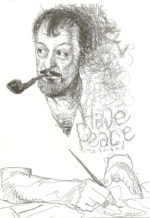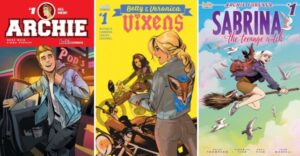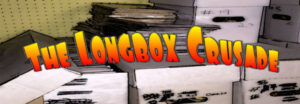The Groovy Age: Mystery Days at Riverdale High
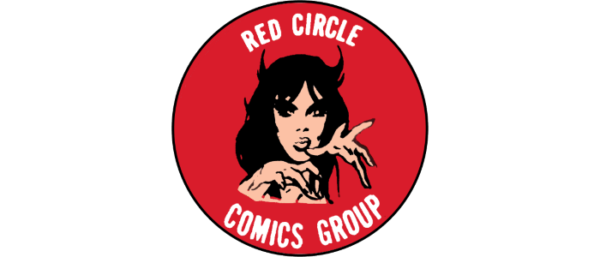
by Jonathan A. Gilbert
As has been stated in earlier installments of The Groovy Age, the ’70s has been a much maligned period of comic book history. While the industry did suffer problems during that decade (the major ones being poor circulation and declining sales), it also went through a period of innovation and experimentation of which the ramifications can still be seen in today’s comic magazines.
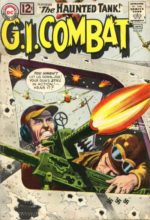 The 70s was also a period of diversification. Unlike today, there was a wide selection of genres for the comics reader to choose from. While superheroes were, as they remain today, the dominant force on the newsstands, there also existed comics featuring jungle adventures (The Phantom, Tarzan, Brothers of the Spear), auto racing (Hot Rods and Racing Cars), martial artists (Yang, House of Yang), adventure (Vengeance Squad), war (GI Combat, Our Fighting Forces, Fightin’ Army), and other material. Of these alternatives to superheroes, the most prominent one, particularly during the first part of the decade, were the mystery comics.
The 70s was also a period of diversification. Unlike today, there was a wide selection of genres for the comics reader to choose from. While superheroes were, as they remain today, the dominant force on the newsstands, there also existed comics featuring jungle adventures (The Phantom, Tarzan, Brothers of the Spear), auto racing (Hot Rods and Racing Cars), martial artists (Yang, House of Yang), adventure (Vengeance Squad), war (GI Combat, Our Fighting Forces, Fightin’ Army), and other material. Of these alternatives to superheroes, the most prominent one, particularly during the first part of the decade, were the mystery comics.
While mystery comics had been on the stands since the introduction of the Comics Code eliminated horror comics in the mid-1950s, it wasn’t until the late ’60s when DC Comics (then called National Periodical Publications) replaced its failing superhero series in such titles as House of Mystery and House of Secrets, that the mystery genre began to attract the attention of a large number of readers. By the early ’70s, especially after the liberalization of the Comics Code gave comics companies more freedom in the types of stories they could publish, the mystery comics were a major force on the spin racks and were even influencing the material appearing in non-mystery comics. It was not unusual during that period to find mystery-influenced superheroes (Ghost Rider, Werewolf By Night), romance (Dark Mansion of Forbidden Love) westerns (Night Rider), and even humor (Plop!).
A number of comics companies published mystery comics during this period. DC/National and Marvel Comics, as well as Chariton (Haunted and The Many Ghosts of Dr. Graves), Gold Key (Twilight Zone and Dark Shadows), and the short lived Atlas Comics (Tales of Evil and Weird Tales of the Macabre) were all putting out mystery comics in hopes of increasing their bottom line. the company that took most readers by surprise when it brought out a line of mystery comics, though, was Archie Publications.
The year was 1973. Having finally gotten over the disappointing failure of its superhero line of the mid-’60s, Archie Publications decided it was time once more to try publishing genres other than humor. Noticing that mystery comics were the going craze, Richard Goldwater and Michael Silberkeit (sons of two of the company’s three founders) decided that was the direction to go. With GRAY MORROW as editor, over a fifteen month period Archie Publications released two bi-monthly anthology mystery titles, one issue of a comic based on a popular book and movie of the time, and came within an angel’s breath of reviving one of its superheroes from the ’40s and ’60s. Calling the line Red Circle Comics Group (based on the name of the pulp fiction publishing company that Michael Silberkleit’s father jointly owned with MARTIN GOODMAN in the 1930s), Archie Music Corporation (as Archie Publications was then called) published stories by such talented writers and artists as FRANK THORNE, BRUCE JONES, STEVE SKEATES, T. CASEY BRENNAN, DON GLUT, AL McWILLIAMS, and CARLOS PING. Incorporating aspects of science fiction, classic horror, hero-oriented pulp fiction and other genres, these and other comics creators produced stories that were among the best of their day.
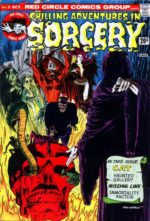 The first comic published under the Red Circle imprint was Chilling Adventures in Sorcery #3. continuing it’s numbering from an Archie title that had been published in 1972 (which had featured Sabrina, the Teenage Witch), the publishers changed its name to Red Circle Sorcery with issue #6. Sorcery ran from #3 (October, 1973) to #11 (February, 1975). Gray Morrow’s cover for this first issue not only set the tone for the book, but for the line as a whole. In the foreground stood a white-skinned, purple-cloaked and hooded figure whose face was concealed by dark shadows. With one hand, this figure pointed at the reader, while with the other it gestured to what was behind it, indicating what the reader should expect if he or she dared to venture behind the confines of the cover-and what an eerie publication it was, too. Directly behind the gesturing hand of the figure, at the bottom left part of the cover was a large, scarlet, human skull on which crawled demons of various sorts, and out of one eye socket poked a hideous serpent. Behind the skull was a field of fire, and standing there in the foreground were numerous nightmarish creatures, including a mist-like ghost with monstrous hands, a red-skinned, bat-winged devil-like creature, and a stunningly gorgeous female vampire with a bell made of tiny human skulls. Behind them rose a stark, cold, ancient castle set on a chilling blue background. Needless to say that, combined with the Red Circle slug and bat, and the title logo, even from a distance, this issue stood out on the comics stands and spin racks.
The first comic published under the Red Circle imprint was Chilling Adventures in Sorcery #3. continuing it’s numbering from an Archie title that had been published in 1972 (which had featured Sabrina, the Teenage Witch), the publishers changed its name to Red Circle Sorcery with issue #6. Sorcery ran from #3 (October, 1973) to #11 (February, 1975). Gray Morrow’s cover for this first issue not only set the tone for the book, but for the line as a whole. In the foreground stood a white-skinned, purple-cloaked and hooded figure whose face was concealed by dark shadows. With one hand, this figure pointed at the reader, while with the other it gestured to what was behind it, indicating what the reader should expect if he or she dared to venture behind the confines of the cover-and what an eerie publication it was, too. Directly behind the gesturing hand of the figure, at the bottom left part of the cover was a large, scarlet, human skull on which crawled demons of various sorts, and out of one eye socket poked a hideous serpent. Behind the skull was a field of fire, and standing there in the foreground were numerous nightmarish creatures, including a mist-like ghost with monstrous hands, a red-skinned, bat-winged devil-like creature, and a stunningly gorgeous female vampire with a bell made of tiny human skulls. Behind them rose a stark, cold, ancient castle set on a chilling blue background. Needless to say that, combined with the Red Circle slug and bat, and the title logo, even from a distance, this issue stood out on the comics stands and spin racks.
The contents of Chilling Adventures in Sorcery #3 were just as exciting. this issue, as well as most of the other Red circle mystery issues, featured four comics stories, a one page mystery prose story, and a one page text and art filler called “Essays in the Supernatural°. The essay fillers were often even better than the stories, and they dealt with such subjects as the development of the supernatural, possession, and exorcism. It is a sure bet that back in the ’70s, when young people were not as knowledgeable about such subjects as they are today, more than a couple of ten-year-olds would have a sleepless night after reading one of these essays.
The first story of the issue was titled “the Cat” and was, as were all the stories in CATS #3, by Gray Morrow. as with many of Morrow’s well-crafted tales, the title would turn out to have a double meaning. The story, set in modem times, took place in the Caribbean and focused on a down-on-his-luck cat-burglar named Alden Brooks. Having just completed a stretch in prison which “diluted his self-esteem”, Brooks came to this playground of the rich and famous in search of a change of luck. shortly upon his arrival, Brooks saw his opportunity in the form of a beautiful young woman clad in expensive diamonds. Noticing that she was with and elderly and apparently wealthy gentleman, he decided to inquire about the woman. He soon learned that her name was Consuelo, and that the man, her uncle, known as Senor Atalan, was reputed to have one of the finest jewel collections in the world. Brooks decided to befriend the pair, first by attempting to sweep Senorita Consuelo off her feet, and then by having her introduce him to her uncle.
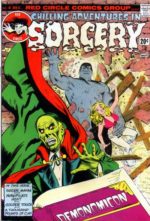 After (through slight of hand) causing the Senorita to lose her diamond bracelet while he was dancing with her in the casino and then locating it, Brooks accompanied the young woman back to the blackjack table where her uncle was. At first Atalan treated Brooks curtly, until the incident with the bracelet was mentioned, at which time Consuelo’s uncle became friendlier and invited him to dinner the next evening as a show of gratitude for Brooks’ recovering the valuable. Faking embarrassment because of Alston’s gesture, Brooks nonetheless accepted the offer, seeing it as an opportunity to confirm his hopes that the Senior’s jewelry collection was as valuable as he had been told. As the conversation continues, though, something at the back of Brooks’ mind told him that there was a sinister aura about Senor Atalan and his niece. Much to his own detriment, however, Brooks decided to ignore it.
After (through slight of hand) causing the Senorita to lose her diamond bracelet while he was dancing with her in the casino and then locating it, Brooks accompanied the young woman back to the blackjack table where her uncle was. At first Atalan treated Brooks curtly, until the incident with the bracelet was mentioned, at which time Consuelo’s uncle became friendlier and invited him to dinner the next evening as a show of gratitude for Brooks’ recovering the valuable. Faking embarrassment because of Alston’s gesture, Brooks nonetheless accepted the offer, seeing it as an opportunity to confirm his hopes that the Senior’s jewelry collection was as valuable as he had been told. As the conversation continues, though, something at the back of Brooks’ mind told him that there was a sinister aura about Senor Atalan and his niece. Much to his own detriment, however, Brooks decided to ignore it.
The next evening, Brooks went to Atalan’s mansion where he was treated to a wonderful meal. After dinner, the Senor took him to a special room where he kept his vast diamond and jewel collection. Dazzled by their beauty and value, Brooks immediately began to plan how he would acquire the treasures.
Later that evening, Brooks spent some time with Senorita Consuelo. During their conversation, Brooks limed that Consuelo knew all along that he caused her to “lose” her bracelet and that his plan to befriend her and her uncle so that he could steal Senor Atalan’s jewels. To add to brooks’ surprise, she then offered not only to aid in his plan, but also offered herself in the bargain. Intrigued by her bluntness, Brooks agreed to listen.
Consuelo proceeded to tell Brooks that her uncle was mad, believing himself to be a sorcerer and alchemist. She explained that he devoted his life to the research and study of ancient rites that use gems as talismans. She then added that her uncle was aware that Brooks planned to steal his treasures and had been “enjoying a little game of cat and mouse” with him. She concluded by stating that her uncle had very powerful guardians that would prevent even a successful cat-burglar like Brooks from getting the gems, and the only way for Brooks to succeed would be with her help.
Not quite sure what to make of what Consuelo told him, Brooks decided, nonetheless, to ask what her price was. The young woman told him that she would aid him, and that he could take whatever he wished, as long as he stole for her a diamond pendant which her uncle were around his neck at all times. Referring to it as the medallion of Bast, cat god of ancient Egypt, she explained that it was carved from a single brilliant gem. Brooks accepted her terms, and the pair set out to burgle Senor Atalan’s treasure room later that evening.
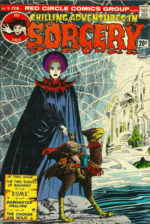
Brooks left, and Consuelo slipped her uncle a drug in his nightcap to make him go to sleep. After waiting the required prod of time for the drug to take effect, Brooks used his cat-burglar equipment to scale the side of Atalan’s mansion and climb into his bedroom, as this was, according to Consuelo, the only way into her uncle’s home that was not protected by one of his guardians. as Brooks scaled the wall, he thought mockingly about what the Senorita had told him about her uncle, and that once he got his hands on the jewels, he would live the Caribbean without her. Upon entering Atalan’s bedroom window, however, he realized that the woman had told him the truth. Gazing about the brazier-Id room, to his shock, Brooks saw equipment that only an alchemist would use. this distracted him only for a moment, however, after which he quietly slipped up to beside the bed on which Senor Atalan slept.
after briefly noticing the beauty of Atalan’s medallion, Brooks swiftly removed it from the Senor’s neck. To Brook’s shock, the next instant Atalan sat upright in his bed, fully awake. The drugs Consuelo slipped Atalan had obviously not worked.
then, before Brooks could recover from the initial shock, an even more unbelievable event took place. Right before the cat-burglar’s eyes, Atalan changed into a cobra and prepared to strike the would-be thief. Brooks produced a revolver, but before he could fire at the cobra, Consuelo appeared in the room. She warned Brooks that the weapon would be useless against the changed Atalan, but told him not to worry because, as Brooks removed the medallion of Bast, Atalan’s protective spell against her was broken. The next instant, Consuelo transformed, taking the shape of a mongoose. Leaping at the cobra that was once her uncle, the mongoose-formed Consuelo killed him in an instant. Free of her uncle, Consuelo returned to her human form and turned her attention to the still-shocked Alden Brooks.
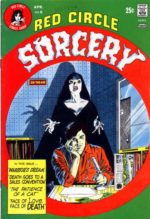 Explaining that she knew Alden had not inter to include her in his plans once she had helped him, but adding that she still felt she owed him a debt for freeing her from her uncle, Consuelo stated she would give him a reward that would befit his nature. She then cast a spell that turned Brooks into a cat, explaining that from that moment on until the end of eternity, he would be her immortal familiar. The final panel depicted the smiling face of the green-eyed Consuelo as she gestured with her delicate hands to clear her spell’s mists to reveal that, where Alden Brooks once stood, in his place stood a small gray and white cat. while neither Alden Brooks nor the cat would ever be used again in Red Circle’s mystery comics, Consuelo would make numerous appearances as the host of sorts of this comics line. Besides appearing in the center of each of Red Circle Sorcery and DAIS’s Red Circle Comics Group slug (including the one appearing on the cover of CAIS#3), she would also answer reader mail in RCS #9. The other stories in this issue were just as thrilling. The second story, ‘Missing Link”, was a science fiction tale about a scientist who went back in time to the Paleolithic Period in search of the missing link between the Neanderthals and Cro-Magnon man. After a series of events, the scientist realized he himself was the father of the first Cro-Magnon man. In “Immortality Factor”, Arden Miller went to visit his sister who had recently become mentally ill and was interred at a local sanitarium. While visiting, he stumbled upon what he believed was a mad doctor’s experimentation on mentally ill patients, only to discover too late that the doctor was, in fact, experimenting on vampires in hopes of isolating the factor that gave them immortality. The final story, “Haunted Gallery”, was a tale of a “Gas Light” nature, in which a woman hired an artist to paint a series of specially treated paintings to force the man who was also her fiancée, who had killed her wealthy uncle, into confessing his crime.
Explaining that she knew Alden had not inter to include her in his plans once she had helped him, but adding that she still felt she owed him a debt for freeing her from her uncle, Consuelo stated she would give him a reward that would befit his nature. She then cast a spell that turned Brooks into a cat, explaining that from that moment on until the end of eternity, he would be her immortal familiar. The final panel depicted the smiling face of the green-eyed Consuelo as she gestured with her delicate hands to clear her spell’s mists to reveal that, where Alden Brooks once stood, in his place stood a small gray and white cat. while neither Alden Brooks nor the cat would ever be used again in Red Circle’s mystery comics, Consuelo would make numerous appearances as the host of sorts of this comics line. Besides appearing in the center of each of Red Circle Sorcery and DAIS’s Red Circle Comics Group slug (including the one appearing on the cover of CAIS#3), she would also answer reader mail in RCS #9. The other stories in this issue were just as thrilling. The second story, ‘Missing Link”, was a science fiction tale about a scientist who went back in time to the Paleolithic Period in search of the missing link between the Neanderthals and Cro-Magnon man. After a series of events, the scientist realized he himself was the father of the first Cro-Magnon man. In “Immortality Factor”, Arden Miller went to visit his sister who had recently become mentally ill and was interred at a local sanitarium. While visiting, he stumbled upon what he believed was a mad doctor’s experimentation on mentally ill patients, only to discover too late that the doctor was, in fact, experimenting on vampires in hopes of isolating the factor that gave them immortality. The final story, “Haunted Gallery”, was a tale of a “Gas Light” nature, in which a woman hired an artist to paint a series of specially treated paintings to force the man who was also her fiancée, who had killed her wealthy uncle, into confessing his crime.
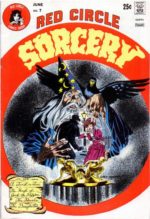 The stories in subsequent issues of Chilling Adventures in Sorcery/Red Circle Sorcery were just as bone rattling. while there isn’t space to mention each and every one, there are some of particular note worth bringing to your attention. In Red Circle Sorcery #7 (June, 1974), Steve Skeates wrote a story titled “A Twist in Time”. Beautifully rendered by Carlos Pino, this tale told of how Merlin, while attempting to use his crystal ball to spy on the enemies of King Arthur, inadvertently locked onto the life of a criminal in the 20th Century, and each time the criminal slept, Merlin’s face was part of an image in the criminal’s dreams in which he was haunted by a man he had murdered. The dreams went on for weeks, and each time the criminal’s victim would stand, with the image of Merlin behind him, pointing at the criminal and telling him that the face behind the victim was the face of the man who would cause his death. Slowly but surely, this wore the criminal down to the point that he would sleep for fear of seeing the face again. Not long after his last dream, after coming out of a coffee shop, the criminal decided to go on a ride with his windows open in hopes that the rush of air would keep him awake. As he rode along, he saw something that sent him into a state of panic, resulting in him driving into a watt and instantly killing himself. The reader then learns that what the criminal had seen was a man dressed up for a costume ball who looked exactly like Merlin’s image from the dream.
The stories in subsequent issues of Chilling Adventures in Sorcery/Red Circle Sorcery were just as bone rattling. while there isn’t space to mention each and every one, there are some of particular note worth bringing to your attention. In Red Circle Sorcery #7 (June, 1974), Steve Skeates wrote a story titled “A Twist in Time”. Beautifully rendered by Carlos Pino, this tale told of how Merlin, while attempting to use his crystal ball to spy on the enemies of King Arthur, inadvertently locked onto the life of a criminal in the 20th Century, and each time the criminal slept, Merlin’s face was part of an image in the criminal’s dreams in which he was haunted by a man he had murdered. The dreams went on for weeks, and each time the criminal’s victim would stand, with the image of Merlin behind him, pointing at the criminal and telling him that the face behind the victim was the face of the man who would cause his death. Slowly but surely, this wore the criminal down to the point that he would sleep for fear of seeing the face again. Not long after his last dream, after coming out of a coffee shop, the criminal decided to go on a ride with his windows open in hopes that the rush of air would keep him awake. As he rode along, he saw something that sent him into a state of panic, resulting in him driving into a watt and instantly killing himself. The reader then learns that what the criminal had seen was a man dressed up for a costume ball who looked exactly like Merlin’s image from the dream.
Another story from that issue was “The Benefactor” by T. Casey Brennan. This four page tale dealt with a mysterious, human-looking but alien entity that had come to earth to give a mysterious gift of understanding to someone on earth, but found that humanity was not willing to accept what he offered. “The Benefactor” was a particular favorite of this writer, and the title character of the piece was but one of many influences for his Destiny character (who will be debuting in the not-too-distant future in Solomon Wyrd.)
Not all of Red Circle Sorcery’s tales dealt with things dark and mysterious. One of the lighter stories was “One Evening On A Small Planet” which appeared in issue #10 of that title. Written by Ed Newsome with art by AI McWilliams, this three page vignette had a father and daughters watching TV when a news bulletin came on announcing that a mysterious UFO had been sighted during that day over south Africa, the Syrian Desert, and Stockholm, and at that point was reported to have been seen hovering over St. Louis. Switching to the news camera on the scene, the news bulletin then began to broadcast shots of the UFO live to the nation. As this was going on , two futuristically garbed, ape-like humanoids stepped out of the saucer-shaped vehicle, began to survey their surroundings. as the people who had gathered on the ground began to panic, the pair discussed the planet below. It quickly became apparent to the reader, but not to the people in the story) that an interstellar real-estate sale was taking place the potential purchaser expressed interest but found the “nasty bipeds’ on the ground annoying and wondered if something could be done about them. The real-estate agent said he’d call in an exterminator, and with that the deal was made.
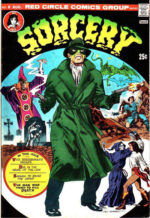 For fans of costumed heroes and masked crime-fighters, the most enjoyable story to appear during Red Circle Sorcery’s nine issue run was “Die in the Name of the Law!” (RCS #8) Scripted by Marv Channing (who wrote a number of stories for the Red Circle Comics Group and other publishers in the early and mid-’70s and has since vanished from the comics one) with art (and most likely by Gray Morrow, this five page tale was about an art director for an advertising agency who became possessed by the spirit of a 30s pub fiction mystery man called the GREEN COBRA. This was the only time in the ’70s that the Red Circle Comics Group came anywhere nay publishing anything resembling a superhero during its existence, and it was suspected by some readers at the time that “Die in the Name of the Law!” was meant as a test to see if there was any interest in a superhero series in general or a GREEN COBRA series in particular. As Red Circle had planned to release a costumed crime fighter title (a subject which well cover a little bit later), we knew that they must have felt there was some interest in them publishing one. Unfortunately as the 70s Red Comics Group folded six months after the appearance of the GREEN COBRA, we’ll never know for sure if they had any future plans for the GREEN COBRA.
For fans of costumed heroes and masked crime-fighters, the most enjoyable story to appear during Red Circle Sorcery’s nine issue run was “Die in the Name of the Law!” (RCS #8) Scripted by Marv Channing (who wrote a number of stories for the Red Circle Comics Group and other publishers in the early and mid-’70s and has since vanished from the comics one) with art (and most likely by Gray Morrow, this five page tale was about an art director for an advertising agency who became possessed by the spirit of a 30s pub fiction mystery man called the GREEN COBRA. This was the only time in the ’70s that the Red Circle Comics Group came anywhere nay publishing anything resembling a superhero during its existence, and it was suspected by some readers at the time that “Die in the Name of the Law!” was meant as a test to see if there was any interest in a superhero series in general or a GREEN COBRA series in particular. As Red Circle had planned to release a costumed crime fighter title (a subject which well cover a little bit later), we knew that they must have felt there was some interest in them publishing one. Unfortunately as the 70s Red Comics Group folded six months after the appearance of the GREEN COBRA, we’ll never know for sure if they had any future plans for the GREEN COBRA.
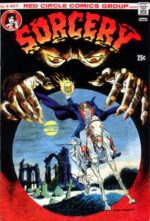 We might have known if Red Circle had run a regular letters page in its titles, unfortunately, it didn’t. Richard Goldwater and Gray Morrow preferred to use the space in their titles for regular stories and features. They must, though, have received a great deal of mail requesting a letters page, as in Red Circle Sorcery #9 (October, 1974) (by which time, for those of you who are interested, Archie Music Corporation’s name had been changed to Red Circle Productions, Inc. in the as the publisher, though the address was stiff the same as before), they printed a half page of letters with editorial responses. With letters “answered” by Consuelo (calling herself the SORCERESS) from Chilling Adventures in Sorcery #a, riders learned that Red ate had big plans for the future- Among the things stated for the future were a “Golden Age revival tine” (which was in preparation during the time the letters page was put together), a mystery-detective series, sword and sorcery comics, and superhero adventures. As the Red Circle imprint ceased to exist a feet months later, readers never got a chance to see any of these announced magazines make it to print. Was the mystery-detective material mentioned a GREEN COBRA series? We learned of one “Golden Age revival” just before Red Circle vanished again (well get to that soon), but were others planned? What superheroes did the SORCERESS have in mind when she brought up the subject in the letters page? Did Red Circle intend to eventually revive the FLY, the SHIELD, and other MLJ/Mighty Comics Group characters? We’ll probably never learn the answer to these questions, but they have always been on the minds of fans of the 70s Red Circle Cams Group. It would be interesting to learn if somewhere, deep in the vaults of Archie Productions, there are some camera ready GREEN COBRA stories or superhero tales planned for this period just waiting to be discovered.
We might have known if Red Circle had run a regular letters page in its titles, unfortunately, it didn’t. Richard Goldwater and Gray Morrow preferred to use the space in their titles for regular stories and features. They must, though, have received a great deal of mail requesting a letters page, as in Red Circle Sorcery #9 (October, 1974) (by which time, for those of you who are interested, Archie Music Corporation’s name had been changed to Red Circle Productions, Inc. in the as the publisher, though the address was stiff the same as before), they printed a half page of letters with editorial responses. With letters “answered” by Consuelo (calling herself the SORCERESS) from Chilling Adventures in Sorcery #a, riders learned that Red ate had big plans for the future- Among the things stated for the future were a “Golden Age revival tine” (which was in preparation during the time the letters page was put together), a mystery-detective series, sword and sorcery comics, and superhero adventures. As the Red Circle imprint ceased to exist a feet months later, readers never got a chance to see any of these announced magazines make it to print. Was the mystery-detective material mentioned a GREEN COBRA series? We learned of one “Golden Age revival” just before Red Circle vanished again (well get to that soon), but were others planned? What superheroes did the SORCERESS have in mind when she brought up the subject in the letters page? Did Red Circle intend to eventually revive the FLY, the SHIELD, and other MLJ/Mighty Comics Group characters? We’ll probably never learn the answer to these questions, but they have always been on the minds of fans of the 70s Red Circle Cams Group. It would be interesting to learn if somewhere, deep in the vaults of Archie Productions, there are some camera ready GREEN COBRA stories or superhero tales planned for this period just waiting to be discovered.
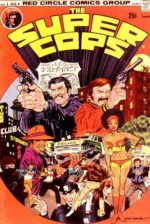 While none of the 70s Red Circle’s announced plans in the letters column took place, the line did expand. With a cover date of July, 1974, the second Red Circle comic to hit the stands was Super Cops. Lasting only one issue, this title as based on the popular, same-titled book and movie of the day about the rest-life exploits of NYC cops Dave Greenburg and Bob Hantz. While the names Greenburg and Hantz have little meaning to the general pubic today, back in the early 70s, this pair were minor celebrities. Referred do as a real life “Batman and Robin” team by the press during their time on the New York City Police Force, Greenburg and Hantz made headlines for their rather unorthodox methods to shut down the drug market in Brooklyn’s Bedford-Stuyvesant area. Their exploits were later recounted in a book and movie, which were funny, hard hitting, and extremely entertainment. The comic book, on the other hand, was another matter. Rather than go for the book-length tale, Red Circle decided to publish a series of vignettes, which, if you weren’t familial with the book or movie, would have left you scratching your head, and wondering what alt the fuss was about. While Super Cops did, and still does, have the potential to make an exerting comic book series, Red Circle’s approach was not the direction to take the series in. In any case, fans of the Super Cops didn’t have to suffer long, because this poorly crafted version only lasted the one issue. Although it had nothing to do with it, this comic was blamed, by some fans of Greenburg and Hantz, for the demise of their heroes’ popularity.
While none of the 70s Red Circle’s announced plans in the letters column took place, the line did expand. With a cover date of July, 1974, the second Red Circle comic to hit the stands was Super Cops. Lasting only one issue, this title as based on the popular, same-titled book and movie of the day about the rest-life exploits of NYC cops Dave Greenburg and Bob Hantz. While the names Greenburg and Hantz have little meaning to the general pubic today, back in the early 70s, this pair were minor celebrities. Referred do as a real life “Batman and Robin” team by the press during their time on the New York City Police Force, Greenburg and Hantz made headlines for their rather unorthodox methods to shut down the drug market in Brooklyn’s Bedford-Stuyvesant area. Their exploits were later recounted in a book and movie, which were funny, hard hitting, and extremely entertainment. The comic book, on the other hand, was another matter. Rather than go for the book-length tale, Red Circle decided to publish a series of vignettes, which, if you weren’t familial with the book or movie, would have left you scratching your head, and wondering what alt the fuss was about. While Super Cops did, and still does, have the potential to make an exerting comic book series, Red Circle’s approach was not the direction to take the series in. In any case, fans of the Super Cops didn’t have to suffer long, because this poorly crafted version only lasted the one issue. Although it had nothing to do with it, this comic was blamed, by some fans of Greenburg and Hantz, for the demise of their heroes’ popularity.
The 70s Red Circle Comics Group released their third and final title in the early summer of 1974. Called Madhouse (a continuation of Archie’s Madhouse Glads), it, like Red Circle Sorcery, was a mystery anthology and ran for three issues (#95, September, 1974 through #97, January, 1975). as there was no difference between Madhouse and Red Circle Sorcery in the type of material that the two titles presented, fans have often speculated that Red Circle decided to add this title to its imprint rather than increase Red Circle Sorcery to a monthly, because Madhouse Glad’s sales figures were down. Rather than cancel the title (and lose its coveted Second Class Postal standing and possibly valuable newsstand space), they changed the title’s format. Whatever the real reason for the decision, it was an action welcomed by Red Circle fans.
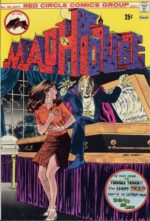 Madhouse, like Red Circle Sorcery, featured some wonderfully crafted mystery tales. Issue #95, for example, featured a Don Glut / Vincent Alcazar tale called the “Terrible Trident!”‘ in which a businessman dressed as Satan on his way to a costume party bought a pitchfork at a costume shop to give his costume a b# more realism. As it turned out, the pitchfork was in fact the Trident of Satan, which had been stolen from the Prince of Darkness by one of the lesser demons of Hell. Drawing Satan’s attention by using the trident to stop a woman from being mugged in an alley, the businessman more than happily turned the weapon back over to the Lord-of -Lies. when the Dreaded One returned to Hell, he took the lesser demon that had stolen the trident with him the demon having just happened to disguise himself as the costume shop owner. When Satan left and the smoke-cleared, the business, who was still in the company of the woman whom he had saved from being mugged, breathed a-sigh of relief, but his respite was short-lived, for in the next instant, the woman revealed to him that she too,-was one of Satan’s demons, sent to earth to find the demon who had stolen the trident. the story concluded with the woman, having taken her true form of the demon Lilith, about to pounce on the terrified businessman-and-take-his soul.
Madhouse, like Red Circle Sorcery, featured some wonderfully crafted mystery tales. Issue #95, for example, featured a Don Glut / Vincent Alcazar tale called the “Terrible Trident!”‘ in which a businessman dressed as Satan on his way to a costume party bought a pitchfork at a costume shop to give his costume a b# more realism. As it turned out, the pitchfork was in fact the Trident of Satan, which had been stolen from the Prince of Darkness by one of the lesser demons of Hell. Drawing Satan’s attention by using the trident to stop a woman from being mugged in an alley, the businessman more than happily turned the weapon back over to the Lord-of -Lies. when the Dreaded One returned to Hell, he took the lesser demon that had stolen the trident with him the demon having just happened to disguise himself as the costume shop owner. When Satan left and the smoke-cleared, the business, who was still in the company of the woman whom he had saved from being mugged, breathed a-sigh of relief, but his respite was short-lived, for in the next instant, the woman revealed to him that she too,-was one of Satan’s demons, sent to earth to find the demon who had stolen the trident. the story concluded with the woman, having taken her true form of the demon Lilith, about to pounce on the terrified businessman-and-take-his soul.
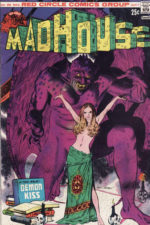 Another well-crafted tale appeared in Madhouse #96 (November,- t974)- and was called- Demon Kiss”. Written and drawn (and possibly lettered) by Bruce Jones, this seven page yarn was about a young Malibu woman named Valerie Newton who sold her soul to the devil in return for a part in a major motion picture. According to this agreement, her soul would be Satan’s possession at the end of one year. As is always the case in such matters, however, there was an apparent escape clause: if Valerie kissed a stranger on the Witching Hour under a full moon before the year was up, Satan would claim her victim’s soul instead.
Another well-crafted tale appeared in Madhouse #96 (November,- t974)- and was called- Demon Kiss”. Written and drawn (and possibly lettered) by Bruce Jones, this seven page yarn was about a young Malibu woman named Valerie Newton who sold her soul to the devil in return for a part in a major motion picture. According to this agreement, her soul would be Satan’s possession at the end of one year. As is always the case in such matters, however, there was an apparent escape clause: if Valerie kissed a stranger on the Witching Hour under a full moon before the year was up, Satan would claim her victim’s soul instead.
The story progressed as one would expect. Valerie got her part and then proceeded to track down and at the proper time kiss the biggest loser she could find. Once this was done, Valerie brushed the stranger off. Unfortunately for Valerie, the loser wasn’t going to take rejection the way she had hoped, and he began pursuing her. This could have been disastrous for Valerie, for if the stranger managed to kiss her back, then the kiss she gave him would be nullified, and Satan would then come-to claim-fret soul. With the year long agreement coming to an end, Valerie decided to take the next plane to Florida and wait the lime out. Again, Valerie didn’t seem to be-having-much luck, for shortly after she arrived, she had a boating accident. Walking up in a hospital some time later, Valerie was informed by a nurse that she would have died if a stranger hadn’t given her mouth-to-mouth resuscitation the-beach. After the nurse left the room, Valerie decided to take a look at the newspaper beside her bed, because the nurse had informed her that
it told the full story about what had happened. Valerie was horrified when she looked at the photograph that accompanied the article, for the stranger who gave her mouth-to-mouth was the same man she had come to Florida to escape. the last panel showed Satan appearing in Valerie’s hospital room to claim tier soul Her year had run out.
A personal comment at this point if I may. As you know, one of the myths about male comic book fans. Is that we, me being one of them (a male comic book fan, I mean), have a hard time relating to the opposite sex. While we all know of examples of this, we also know that for the most part; this is nothing more than art urban legend. Still, after re-reading “Demon Kiss” for this article, and having rest tots of other stories over the years about women trying to put a curse or something on a male, it leaves me wondering if, in the cases where a male comic book reader has had problem relating to women, stories like this might faire some sort of influence on someone who was already inclined to feel that way. Hmm.
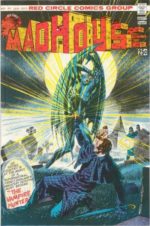 Madhouse #97 (January, 1975), the last issue of the title, featured a wonderful six page tale by Marvin Charming and Frank Thorne called “The Vampire Hunter”. Set in the late 19th Century London, England, this tale dealt with a SHERLOCK HOLMES type character named Henry Hobson who, with the assistance of a Watson-like character called Inspector Walker, tracked down and destroyed a vampire called Prince Volgia. Unlike the other stories in Madhouse and Red Circle Sorcery, had no twist ending, but was, instead, a straight forward detective-mystery tale. Could this have been the first installment of the detective-mystery series that was mentioned in the letters page of Red Circle Sorcery #9? As this was the fast issue of Madhouse (and because the entire ’70s Red Circle imprint vanished after the publication of Red Circle Sorcery #11 one month later), chances are welt never know the answer.
Madhouse #97 (January, 1975), the last issue of the title, featured a wonderful six page tale by Marvin Charming and Frank Thorne called “The Vampire Hunter”. Set in the late 19th Century London, England, this tale dealt with a SHERLOCK HOLMES type character named Henry Hobson who, with the assistance of a Watson-like character called Inspector Walker, tracked down and destroyed a vampire called Prince Volgia. Unlike the other stories in Madhouse and Red Circle Sorcery, had no twist ending, but was, instead, a straight forward detective-mystery tale. Could this have been the first installment of the detective-mystery series that was mentioned in the letters page of Red Circle Sorcery #9? As this was the fast issue of Madhouse (and because the entire ’70s Red Circle imprint vanished after the publication of Red Circle Sorcery #11 one month later), chances are welt never know the answer.
A fourth title was slated for release by the Red Circle Comics Group in the early part of 1975, but as the Red Circle imprint was abruptly pied with the (cover dated) February issue of Red Circle Sorcery, it never saw the light of day at least not in its original form
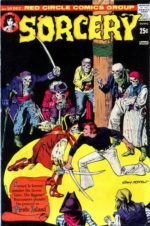 As had been previously announced in the letters column of Real Circle Sorcery #9, Red Circle planned to revive some of its Golden Age characters. Toward this end, Gray Morrow, according to a text piece by Robin, Snyder in the first issue of the ’80s Red Circle Black Hood title, had been poring over bound volumes of comics in the Archie library to find a character to launch the Golden Age revival line and came upon the BLACK HOOD. Not all that interested in starting out with a super-powered costumed adventurer, Morrow decided that, with some alterations, this character might suit his needs and interests. Keeping the BLACK HOOD’s civilian identity of police officer Kip Burland, but tossing out his yellow and black tights, Morrow dressed him in jeans, boots, gloves, and a leather jacket, had him put on a simple black hood, and take part in straight forward crime-tales where he would battle criminals who were outside the jurisdiction of the law. He was-also given a number of gimmick weapons, such as a double barreled, one-handed shotgun, a gas projectile-firing handgun, plus he tied the new hero into the original BLACK HOOD (who had appeared in the ’40s and ’60s) by making the two-cousins. At least one issue was completed with four stories featuring material by Morrow, Marv Channing, Al McWilliams, Neal Adams, and Dick Giordano. A “soon-to-be-released” announcement was made in Red Circle Sorcery #10 (December, 1974) and Madhouse #97, but just prior to publication, the-70s Red Circle Comics Group line was canceled, leaving anxious fans to spend months searching the newsstands for a title that would never appear.
As had been previously announced in the letters column of Real Circle Sorcery #9, Red Circle planned to revive some of its Golden Age characters. Toward this end, Gray Morrow, according to a text piece by Robin, Snyder in the first issue of the ’80s Red Circle Black Hood title, had been poring over bound volumes of comics in the Archie library to find a character to launch the Golden Age revival line and came upon the BLACK HOOD. Not all that interested in starting out with a super-powered costumed adventurer, Morrow decided that, with some alterations, this character might suit his needs and interests. Keeping the BLACK HOOD’s civilian identity of police officer Kip Burland, but tossing out his yellow and black tights, Morrow dressed him in jeans, boots, gloves, and a leather jacket, had him put on a simple black hood, and take part in straight forward crime-tales where he would battle criminals who were outside the jurisdiction of the law. He was-also given a number of gimmick weapons, such as a double barreled, one-handed shotgun, a gas projectile-firing handgun, plus he tied the new hero into the original BLACK HOOD (who had appeared in the ’40s and ’60s) by making the two-cousins. At least one issue was completed with four stories featuring material by Morrow, Marv Channing, Al McWilliams, Neal Adams, and Dick Giordano. A “soon-to-be-released” announcement was made in Red Circle Sorcery #10 (December, 1974) and Madhouse #97, but just prior to publication, the-70s Red Circle Comics Group line was canceled, leaving anxious fans to spend months searching the newsstands for a title that would never appear.
Luckily, though, unlike the other projects Red Circle had announced (and may or may rot have produced material for), the stories that were originally intended for the 1975 Black Hood series did, eventually, see print-twice, actually. The first time the material was published was in 1979. the year before, Archie had released a summer digest called Archie’s Superhero Special, which reprint! stories. from the ’60s Mighty Comics line, plus a SABRINA tale from Chilling Adventures in Sorcery #1, and some of the ’60s stories where Archie, Jughead, and the gang took on superhero identities (the less said about those stories, the be”. the digest was fairly successful, so Archie released a second issue +n the summer of 1979 (changing the title-to Archie’s Superhero Comics Digest Magazine) which not only reprinted more of the same type of material that had appeared in the previous year’s digest, but also the four BLACK HOOD stories that were originally to be published in the first issue of the ’70s Black Hood tide.
This digest, too, was a success, which, combined with a growing direct sales market a couple of years later, led Archie Publications to revive its Red Circle Comics imprint beginning with the All-New Adventures of the Mighty Crusaders #1 (March, 1983). It was during this era of the Red Circle Comics Group that the 70s BLACK HOOD stories saw their second printing. One story, “Black Hood Hits a Sour Note” appeared in Black Hood #1 (June, 1983), and the remaining three were published in Blue Ribbon Comics Vol. 2, #8 (May, 1984).
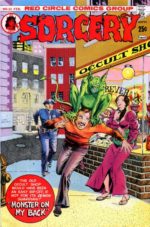 As mentioned earlier, the ’70s Red Circle Comics Group imprint vanished after the publication of Red Circle Sorcery #11 (February, 1975). Madhouse’s last issue was published a month earlier, ending its numbering as a Red Circle title with #97. While Red Circle Sorcery was never seen again, Madhouse returned seven months later (continuing with its Red Circle numbering) as an Archie title featuring satire and humor material and lasted until issue #130 (October, 1982).
As mentioned earlier, the ’70s Red Circle Comics Group imprint vanished after the publication of Red Circle Sorcery #11 (February, 1975). Madhouse’s last issue was published a month earlier, ending its numbering as a Red Circle title with #97. While Red Circle Sorcery was never seen again, Madhouse returned seven months later (continuing with its Red Circle numbering) as an Archie title featuring satire and humor material and lasted until issue #130 (October, 1982).
The full reasoning behind the decision to cancel the 70s Red Circle Comics Group will probably never be known. Fierce competition, a glutted market, and the demise of the mystery fad are just a few of the reasons that have been given over the years by Robin Snyder and others. Whatever the reasons, circumstantial evidence such as the announcement of the release of the Black Hood title and a house ad for Madhouse in Red Circle Sorcery #11 seem to indicate that it was an abrupt decision. Had Archie Publications finally received alt the sales figures from their wholesalers (remember, this was before the days of the direct market, and it often took months and event as long as a year before a publisher learned exactly how many copies a particular titer was selling-and even then the figures were not entirely accurate) and found the numbers to be wanting? It’s possible, but doubtful, as the figures that would have come in around the time the decision was made to cancel Red Circle Comics would have been for sales that took place when sates for mystery comics were at their peak, and ALL titles of this genre, not just those brought out by DC/National and Marvel were flying oft the shelves.
Was the cancellation the result of Archie having second thoughts about publishing mystery comics, fearing that if it became general knowledge, it might somehow affect the sales of their humor books? This does seem a bit more probably, as Archie canes a planned tine of comics featuring a planned line of comics featuring somewhat dark superheroes in the late 1980s for this very reason. This too, is pretty doubtful, however, as, while the wheels of a company’s bureaucracy turn pretty slowly when it comes to making decisions, if such feelings were felt in the boardrooms of Archie Publications, they would have appeared much earlier on in the fife of the ’70s Red Circle Comics Group.
What most likely happened was a combination of the above mentioned possibilities, including the ones mentioned by Robin Snyder. Archie, like just about every other comics company around this time (and for the next few years) was going through some major problems; so taking all the above mentioned factors into consideration, the company heads probably decided it would be better to focus an what they were good at (meaning publishing humor comics targeted at a younger readership) and not taking a chance at breaking into an area they weren’t all that familiar with (nor, possibly, comfortable with) during such volatile limes.
As I said well probably never know the real reason behind the cancellation of the 70s Red Circle Comics Group, but it is always fun to speculate on such matters. One thing that was (and is) known though by the fans of this line, and anyone who has been lucky enough to pick up its issues in the years since its demise, is that they published some pretty dam good mystery tales that gave readers hours of enjoyment, and left them anxiously waiting for more. It also laid the groundwork for the launch of Archie’s second superhero revival some eight years later. But that’s another story that will have to wait for another day-for there are lots more tales to be told about …The Groovy Age!
Copyright © 1998 Jonathan A. Gilbert

